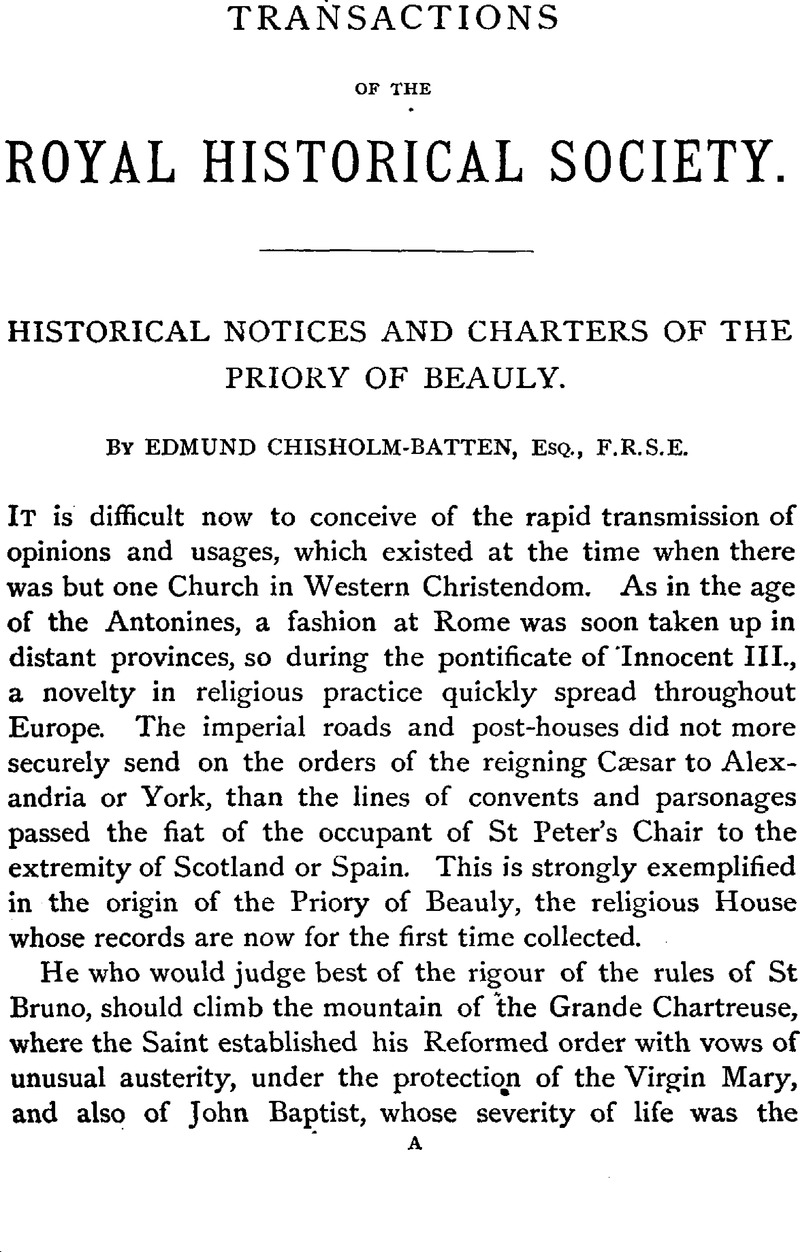No CrossRef data available.
Article contents
Historical Notices and Charters of the Priory of Beauly
Published online by Cambridge University Press: 12 February 2009
Abstract

- Type
- Historical Notices and Charters of the Priory of Beauly
- Information
- Copyright
- Copyright © Royal Historical Society 1876
References
page 3 note * Camb, Giraldus., De Instruct. Princ; Robertson's Preface to Stat. Cone. Ecc. Scot., xxxiv., n. 2Google Scholar.
page 4 note * The Queen υ. the Archbishop of Canterbury, 11 Queen's Bench Reports, 483.
page 4 note † The letter is printed in Appendix to Preface to Stat. Cone. Ecc. Scot., xxx.
page 4 note ‡ Malvoisin went to visit his parents in Normandy in 1212, and probably attended the Council at Paris that year. On his return he presided over a Synod of the Scottish clergy at Perth; on William the Lion's death, 4th December 1214, he enthroned the young king, with more than usual ceremony. He was appointed ambassador to England 9th July 1215.
page 5 note * Yet these clerics, whose name had already become a bye-word, had rights which Malvoisin defended against the dignified Augustinian canons of St Andrews. The hereditary property of the Culdees was possibly attacked, or their right to mutter divine service after their manner in a corner of the cathedral; at all events, in February 1221, the papal legate at Perth heard a litigation commenced by the prior and canons of St Andrews against their bishop and certain clerics of St Andrews, commonly called Culdees—“et quosdam clericos de S. Andrea, qui Keledei vulgariter appellantur” (Theiner, Mon. Vet. Hib. et Scot., p. 16).
page 7 note * This is the probable version of the story of the parish minister of Kilmorack. He says: “In the house of the priests who officiated in this priory, Queen Mary, it is said, was entertained for a night; and upon seeing in the morning the beautiful view from its windows, she exclaimed: ‘C'est un beau lieu,’ and hence the name Beauly was given to the village and river” (Stat. Acct. Inverness-shire, 1842, p. 366). As this minister supposes the name of his parish, Kilmorack, the church of Mary, to be derived from a lady, a descendant of one of the lairds of Chisholm, we must not give him implicit credence. See the amusing criticism on this, Quart. Rev., vol. lxxxii., p. 360.
page 8 note * Histoire des Ordres Monastiques, vol. vi., p. 178.
page 9 note * The canonical hours of prayers were seven, after Ps. cxix. 164: (1.) at 2 A. M.— the monks went to bed at 8 P. M.; (2.) Matins, at6 A. M.; (3.)9. A. M.; (4.) at high noon; (5.)3 P. M.; (6.) Vespers, 6 P. M.; (7.) at 7 P. M. See Concordias Regularum by St Benedict, in Fuller's Church History, book vi., § 3.
page 9 note † In abbeys, the abbot only on great solemnities graced the monks with his' presence in the dining-hall or refectory.
page 9 note ‡ Pulmentum. The ancient Romans lived on the simplest fare, chiefly on pottage (puls), or bread and pot-herbs, hence everything eaten with bread, or besides bread, was afterwards named Pulmentum or Pulmentarium (ψωνιον, opsonium, called in Scotland, Kitchen).—Hor. Sat. ii., 2, 20; Ep. i., 18, 48. Adam's Roman Antiquities, p. 401.
page 11 note * Orem's History of Aberdeen. Bibliotheca Top. Brit, 1790, p. 73.
page 11 note ‡ Preface to the Chartulary of Cambuskenneth, printed for the Grampian Club.
page 12 note * Printed Memoir for Hugh, Lord Lovat, 22d July 1729, p. 22.
page 12 note † Hope's Minor Practicks. Edin. 1734.
page 13 note * There are only three places where they can be, if they were in the custody of Hugh, titular Lord Lovat, in 1729: (1.) In the custody of his personal representatives, or their law agents; (2.) In the custody of the Crown; (3.) In the custody of Mr Fraser of Abertarff. There appears no probability of their being in Lord Lovat's possession.


